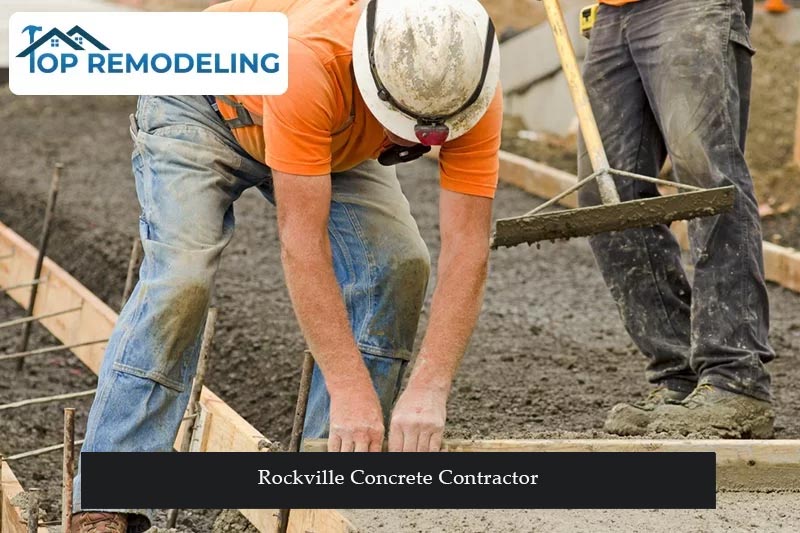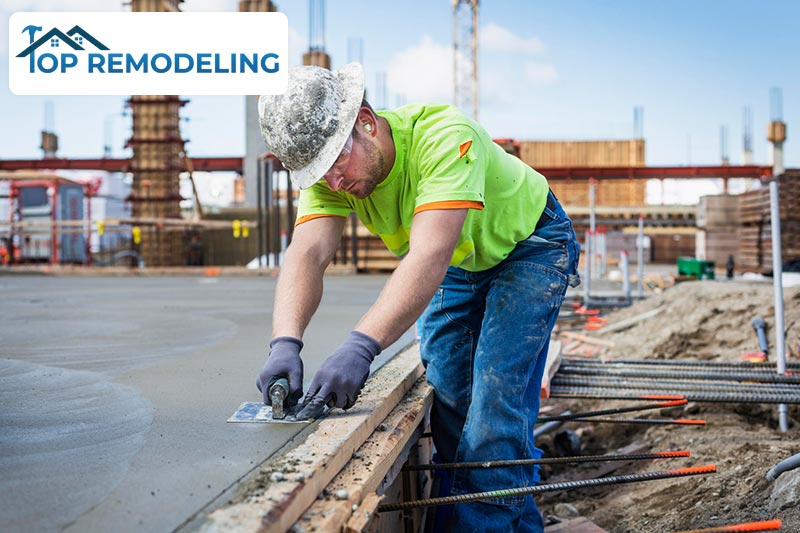Rockville Concrete Contractor with the Widest Range of Services
As a Rockville concrete contractor, we offer a wide range of services, including:

- Stamped Concrete: Stamped concrete is a type of decorative concrete that is patterned and textured to resemble other materials, such as brick, stone, tile, or wood. It involves pouring concrete onto a prepared surface and then using special stamps to imprint the desired pattern onto the surface. Ideal for: Outdoor areas such as driveways, patios, walkways, and pool decks.
- Broom Finish Concrete: Broom finish concrete is a simple and cost-effective way to provide a non-slip surface. After the concrete is poured and smoothed, a broom is used to create a textured pattern on the surface, which helps to prevent slips and falls by providing traction. Broom finish concrete is a practical choice for areas where safety is a priority. Ideal for: Driveways, sidewalks, pool decks, and outdoor areas that may be exposed to water or where safety is a concern.
- Colored Concrete: Colored concrete is achieved by adding pigments or dyes to the concrete mixture before it is poured, resulting in a wide range of color options. This allows for customization and creativity in designing concrete surfaces. Colored concrete can be used to complement the surrounding landscape or architectural style, making it a popular choice for both residential and commercial applications. Ideal for: Driveways, patios, walkways, pool decks, and other places where you need to add a pop of color or complement the surrounding landscape
- Exposed Aggregate Concrete: Exposed aggregate concrete is a type of decorative concrete that exposes the natural texture and beauty of the aggregate (such as pebbles, stones, or shells) used in the concrete mix. After the concrete is poured, the surface is washed or chemically treated to remove the top layer of cement paste, revealing the aggregate underneath. This creates a visually appealing and slip-resistant surface. Ideal for: Driveways, walkways, and pool decks.
- Top Cast Concrete: Top cast concrete, also known as a “topping slab” or “overlay,” is a process in which a thin layer of concrete is applied over an existing concrete surface to improve its appearance or functionality. This can involve resurfacing an old, worn-out concrete surface, covering up imperfections, or adding a decorative finish. Top cast concrete can be customized with various colors, textures, and patterns, making it a versatile option for rejuvenating existing concrete surfaces in a cost-effective manner. Ideal for: Indoor areas like interior floors, and countertops.
Factors that Determine the Cost
- Project Size: The size of the project, measured in square footage or cubic yards of concrete, is a significant factor in determining the cost. Larger projects usually require more materials, labor, and equipment, impacting the overall cost.
- Design Complexity: The complexity of the design, such as intricate patterns, textures, or customizations, can affect the cost of concrete work. More complex designs may require additional labor, materials, and specialized techniques, increasing the overall cost.
- Concrete Type and Mix Design: Different types of concrete, such as standard gray concrete, decorative concrete, or specialty mixes, can have varying costs. Specialty mixes or decorative concrete options, such as stamped or colored concrete, may be more expensive compared to standard gray concrete.
- Site Conditions: Site conditions, such as accessibility, location, and terrain, can impact the cost of concrete work. Difficult-to-reach or remote locations may require additional labor or equipment, which can increase costs. Site conditions with poor soil quality, uneven terrain, or other challenges may also require additional preparation or modifications, affecting the overall cost.
- Labor Costs: Labor costs, including the rates of skilled workers and the project duration, can significantly impact the cost of concrete work. Labor rates can vary depending on location, skill level, and demand, and labor costs usually account for a significant portion of the overall project cost.
- Material Costs: The cost of materials, such as cement, aggregates, reinforcement, coloring agents, and sealants, can also impact the overall cost of concrete work. Material costs can vary depending on the type, quality, and availability of materials, which can affect the total project cost.
- Permitting and Other Fees: Permitting fees, inspections, and other regulatory requirements can add to the overall cost of concrete work. Depending on the location and scope of the project, there may be fees associated with obtaining permits, complying with building codes, and meeting other regulatory requirements.
- Project Timeline: The timeline of the project, including the duration and scheduling, can also affect the cost of concrete work. Projects with tight deadlines or requiring expedited work may incur additional costs, such as overtime labor or expedited material deliveries, which can impact the overall cost.
The Average Costs of Rockville Concrete Projects
Here are the average costs for different types of work. Please note that these are estimates. For a more accurate idea, you can contact our team for Rockville concrete projects and get a detailed estimate for your specific project.

- Stamped Concrete: The cost of stamped concrete ranges from $10 to $20 per square foot, on average. However, the price can vary depending on the complexity of the stamping pattern, the size of the area, and other factors.
- Broom Finish Concrete: Broom finish concrete is generally more affordable compared to other decorative concrete options. The cost of broom finish concrete ranges from $5 to $10 per square foot, on average, but can vary depending on the size of the area and other factors.
- Colored Concrete: The cost of colored concrete can vary depending on the type of coloring method used, such as integral coloring (mixed into the concrete) or staining (applied on the surface). On average, colored concrete can cost from $5 to $15 per square foot, but prices may vary based on the complexity of the coloration and other factors.
- Exposed Aggregate Concrete: Exposed aggregate concrete tends to be on the higher end of the price range for decorative concrete options. The cost of exposed aggregate concrete usually ranges from $8 to $20 per square foot, on average, depending on the type and size of the aggregate used, and other factors.
- Top Cast Concrete: The cost of top cast concrete, or overlays, can vary widely depending on the type of overlay used, the design complexity, and other factors. On average, the cost of top-cast concrete overlays can range from $5 to $20 per square foot or more, depending on the specific application and customization required.
The Timeframes for Your Rockville Concrete Project
The time it takes to complete your Rockville concrete work project also depends on the specific nature of the project. We work by following the best practices of the industry. Not only does it help us to deliver a high level of quality but it also helps to complete the project faster.
Stamped Concrete:
Average Time Taken: 2 to 5 days
The time it takes to complete stamped concrete can vary depending on factors such as the size and complexity of the project, weather conditions, and the experience of the concrete contractor. The overall process includes steps such as preparing the site, pouring the concrete, applying the stamping pattern, adding color and sealant, and allowing time for curing and drying.
Broom Finish Concrete:
Average Time Taken: 1 day
Broom finish concrete is a type of textured finish achieved by running a broom over the surface of freshly poured concrete. The process of broom finishing typically takes place after the concrete has been poured and leveled, and it can usually be completed in a day or less, depending on the size of the area to be finished.
Colored Concrete:
Average Time Taken: 1-2 days added to the overall timeline of a concrete project.
Coloring concrete involves adding pigments or stains to the concrete mixture to achieve the desired color. The time it takes to complete colored concrete can vary depending on factors such as the size of the project, the complexity of the color, and the curing time required for the specific type of coloring used.
Exposed Aggregate Concrete:
Average Time Taken: 3-7 days
Exposed aggregate concrete is a type of decorative concrete finish that exposes the natural aggregates (such as stones or pebbles) on the surface of the concrete. The process of creating exposed aggregate concrete involves pouring the concrete with the aggregates mixed in, and then removing the top layer of cement to reveal the exposed aggregates. The time it takes to complete exposed aggregate concrete can vary depending on factors such as the size and complexity of the project, the type of aggregates used, and the curing time required.
Top Cast Concrete
Average Time Taken: 2-5 days
Top-cast concrete is a technique where a layer of cementitious material is applied on top of an existing concrete surface to create a new finish or overlay. The time it takes to complete top-cast concrete can vary depending on factors such as the size and condition of the existing concrete surface, the type of top-cast material used, and the curing time required.
Get In Touch
If you want to simplify your remodeling process, without compromising on the quality, give us a call today. Get a free and detailed quote from our experts today.
